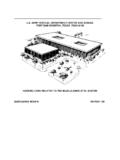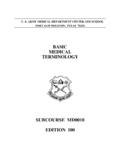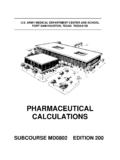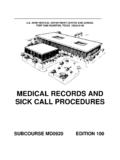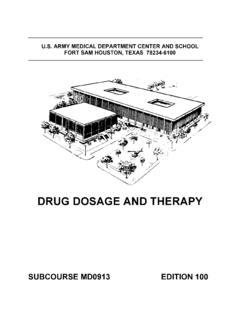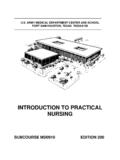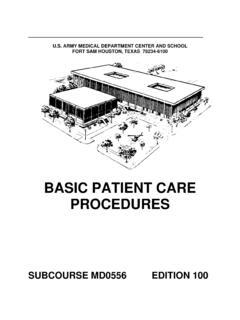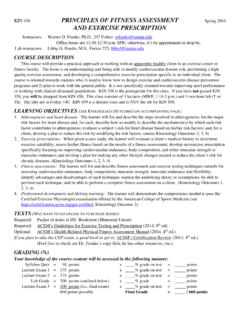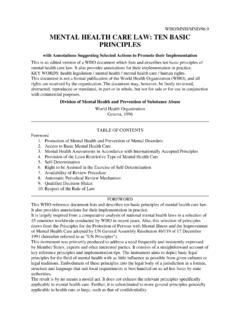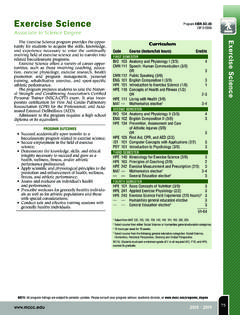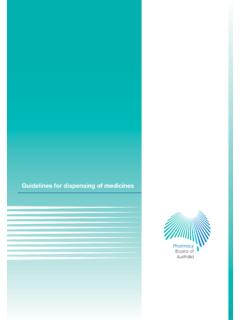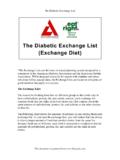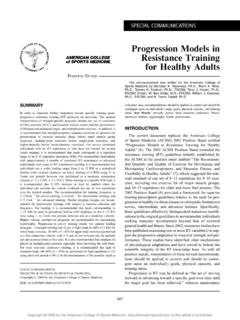Transcription of THERAPEUTICS I - Nursing 411
1 ARMY MEDICAL DEPARTMENT CENTER AND SCHOOL FORT SAM HOUSTON, TEXAS 78234-6100 THERAPEUTICS I SUBCOURSE MD0804 EDITION 200 DEVELOPMENT This subcourse is approved for resident and correspondence course instruction. It reflects the current thought of the Academy of Health Sciences and conforms to printed Department of the Army doctrine as closely as currently possible. Development and progress render such doctrine continuously subject to change. ADMINISTRATION For comments or questions regarding enrollment, student records, or shipments, contact the Nonresident Instruction Section at DSN 471-5877, commercial (210) 221-5877, toll-free 1-800-344-2380; fax: 210-221-4012 or DSN 471-4012, e-mail or write to: COMMANDER AMEDDC&S ATTN MCCS HSN 2105 11TH STREET SUITE 4192 FORT SAM HOUSTON TX 78234-5064 Approved students whose enrollments remain in good standing may apply to the Nonresident Instruction Section for subsequent courses by telephone, letter, or e-mail.
2 Be sure your social security number is on all correspondence sent to the Academy of Health Sciences. CLARIFICATION OF TRAINING LITERATURE TERMINOLOGY When used in this publication, words such as "he," "him," "his," and "men" are intended to include both the masculine and feminine genders, unless specifically stated otherwise or when obvious in context.. USE OF PROPRIETARY NAMES The initial letters of the names of some products are capitalized in this subcourse. Such names are proprietary names, that is, brand names or trademarks. Proprietary names have been used in this subcourse only to make it a more effective learning aid. The use of any name, proprietary or otherwise, should not be interpreted as an endorsement, deprecation, or criticism of a product; nor should such use be considered to interpret the validity of proprietary rights in a name, whether it is registered or not.
3 MD0804 i TABLE OF CONTENTS Lesson Paragraphs INTRODUCTION 1 PROFESSIONAL REFERENCES IN PHARMACY Section I. General .. 1-1--1-2 Section II. Pharmaceutical 1-3--1-4 Section III. Pharmaceutical Texts .. 1-5--1-6 Section IV. Electronic Drug Information 1-7--1-8 Exercises 2 ANATOMY, PHYSIOLOGY, AND PATHOLOGY IMPORTANT TO THERAPEUTICS Section I. Principles of Anatomy and Physiology.
4 2-1--2-3 Section II. 2-4--2-7 Section III. Tissue .. 2-8--2-9 Section IV. 2-10--2-15 Section V. Nature and Causes of 2-16--2-17 Section VI. Treatment of Disease and 2-18--2-20 Exercises 3 INTRODUCTION TO PHARMACOLOGY Section I. Terms and Definitions Important in Pharmacology .. 3-1--3-2 Section II. Introduction to 3-3--3-4 Section III. Considerations of Drug 3-5--3-6 Section IV. Factors Which Influence Drug 3-7--3-15 Exercises 4 LOCAL ANESTHETIC AGENTS Section I.
5 Background 4-1--4-6 Section II. Local Anesthetics and Their Clinical Uses .. 4-7--4-8 Exercises MD0804 ii Lesson Paragraphs 5 THE CENTRAL NERVOUS SYSTEM Section I. Basic Concepts of the Nervous 5-1--5-2 Section II. The Neuron and its "Connections".. 5-3--5-9 Section III. The Human Central Nervous 5-10--5-15 Exercises 6 AGENTS USED DURING SURGERY Section I. General Anesthetic 6-1--6-4 Section II. Other Agents Used During 6-5--6-10 Exercises 7 SEDATIVE AND HYPNOTIC AGENTS Section I.
6 7-1--7-2 Section II. Clinically Important Information Concerning Sedative-Hypnotics .. 7-3--7-7 Section III. Classification of Sedative- Hypnotic 7-8--7-9 Exercises 8 ANTICONVULSANT AGENTS Section I. Review of Epilepsy .. 8-1--8-3 Section II. Anticonvulsant Therapy .. 8-4--8-5 Exercises 9 PSYCHOTHERAPEUTIC AGENTS Section I. 9-1--9-3 Section II. Antianxiety Agents .. 9-4--9-9 Section III. Antidepressant 9-10--9-14 Section IV. Antipsychotic 9-15--9-20 Exercises MD0804 iii Lesson Paragraphs 10 CENTRAL NERVOUS SYSTEM (CNS) STIMULANTS Section I.
7 10-1--10-3 Section II. Cerebral or Psychomotor Agents .. 10-4--10-5 Section III. Analeptic Agents (Brain Stem Stimulants) .. 10-6--10-7 Section IV. Convulsants (Spinal Cord Stimulants) .. 10-8--10-9 Exercises 11 NARCOTIC AGENTS Section I. 11-1--11-4 Section II. Narcotic Agents and Narcotic 11-5--11-7 Exercises ANNEX: DRUG PRONUNCIATION GUIDE MD0804 iv CORRESPONDENCE COURSE OF ARMY MEDICAL DEPARTMENT CENTER AND SCHOOL SUBCOURSE MD08O4 THERAPEUTICS I INTRODUCTION A patient who visits a physician or physician extender frequently receives a prescription for a medication.
8 That prescription is brought to the pharmacy to be filled. The patient expects professional attention at the pharmacy. Part of that expectation involves any caution or warning the patient should heed while taking the medication. In your role, you will serve as a source of drug information. Patients and friends will ask you specific questions concerning the use of prescription and over-the-counter medications. You must know the trade and generic names of literally hundreds of medications. Furthermore, you must know the cautions and warnings associated with many agents. How are you to know this information about drugs? Certainly you have had instruction which presented the basics of anatomy, physiology, and pharmacology.
9 This instruction has given you a sound foundation for learning more in these areas. This subcourse will present instruction in anatomy, physiology, and pharmacology. The material in anatomy and physiology is included to refresh your memory or to give you additional information so you can better understand the pharmacology material. This subcourse is not intended to be used as an authoritative source of drug information. As you know, new drugs are constantly being discovered and new uses for existing drugs are being found through research. Therefore, you must rely upon this subcourse to review concepts or to learn new information. You are then to use other sources (see lesson 1 of this subcourse) to gain new information as it is discovered.
10 Subcourse Components: This subcourse consists of 11 lessons. The lessons are: Lesson 1. Professional References in Pharmacy. Lesson 2. Anatomy, Physiology, and Pathology Important to THERAPEUTICS . Lesson 3. Introduction to Pharmacology. Lesson 4. Local Anesthetic Agents. Lesson 5. The Central Nervous System. Lesson 6. Agents Used During Surgery. Lesson 7. Sedative and Hypnotic Agents. Lesson 8. Anticonvulsant Agents. MD0804 v Lesson 9. Psychotherapeutic Agents. Lesson 10. Central Nervous System (CNS) Stimulants. Lesson 11. Narcotic Agents. --Read and study each lesson carefully.
